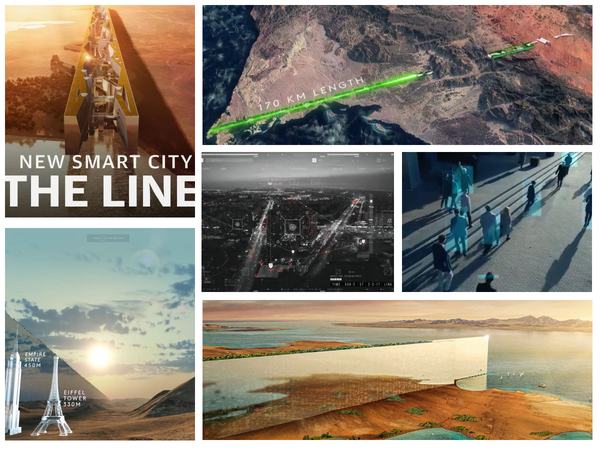Christine Anderson on Smart Cities & NEOM
Christine Anderson MdEP on Smart Cities/15-minute cities, Digital Pass, Great Britain’s Climate Lockdowns, and Saudi Arabia’s “The Line”
Christine Anderson on Smart Cities
2min Clip: Twitter | Rumble
1min Clip: Telegram | Rumble | Rumble-Mirror | Telegram-Mirror
Full Video: Rumble | EpochTimes | Telegram
I’m very curious what your opinion is on 15-minute cities. This is something that, I guess it’s a new idea that we’re only beginning to hear about. Maybe you can actually remind us what they are, and I understand they’re coming in Europe now. There’s legislation pushing in that direction already.
Yes, it is. The digital Green Certificate, the COVID pass, that was a test balloon to get people to having to produce some kind of a QR code. You know, just getting people used to that. Now what they’re slamming us with is these 15-minute cities.
Make no mistake, it’s not about your convenience. It’s not that they want you to be able to, you know, have all of these places that you need to get to very close, and it’s not about saving the planet either, by the way.
The 15-minute cities, they will have to have those before they can lock you down, and that’s what we were talking about here.
So in Great Britain, some county already passed legislation, they will be able to impose a climate lockdown. That’s the next step. That’s what we were talking about. So in order to do that, they will have to have these 15-minute cities.
The next step, then of course, will be: You are only allowed to leave your immediate area for like two or three times a year. But there are other people that may have more money and they can actually buy your passes off of you. So guess what? The poor people will be left in these 15-minute neighborhoods, while the ones they are better off, get to go wherever they want to go. So this is what we’re talking about.
Look at Saudi Arabia, for instance. They’re putting up Neom city. They call it “The Line.” So this is like a structure in the middle of a desert, 200 kilometers long, 200 meters wide, 500 meters high, and it will house up to 9 million people.
Oh, isn’t that just brilliant. If I wanted to get total control of the people, that’s exactly where and how I would house them, and then having them on a three meals a day prescription, well guess what will happen if you do not do as you are told? They will probably cancel that. It’s so easy. So that’s what we’re talking about, and when you really take all of this together, there is no other way for me to actually say this. It will be a complete impoverishment and enslavement of all the people.
Saudi Arabia’s Mega Smart-City NEOM “The Line”
Saudi Arabian Prince plays Sim City with his Kingdom: building 5-min Surveillance Mega-City in a straight line.
Countless governments and companies have taken a stab at building a city of the future. There’s Songdo in South Korea, the Alphabet-funded Keyside Project in Toronto, which was abandoned in May of last year, and both Singapore and Barcelona have tried to modernize with smart sensors.
In January of 2021, Saudi Arabia announced plans for its own futuristic city called The Line. Instead of communities sprawling outward from a central location, they would be built vertically and arranged, well, in a line, hence the name. Even though the vision for the city stretches 170 kilometers, it would do away with cars entirely and instead be connected by high speed rail that would travel the entire length in just 20 minutes, and each individual community would be largely self-contained so that almost anything you could need, be it a school, a doctor, or a quick meal, would be only a five minute walk away.
The government says The Line will run on 100% clean energy and make extensive use of sensors and AI to manage the city’s services, and all of this is supposed to be nestled in the pristine natural landscape of the taboo province with minimal impact on the environment.
Now the Saudi Crown Prince, Mohammed bin Salman, has revealed grandiose renders of what the city will look like to match the grandiose plans. The Line is envisioned as a giant glass and mirrored wall, 170 kilometers long, 200 meters wide, and 500 meters tall. That’s taller than the Empire State Building. It would have greenery stretching along the top, an open air ventilation system to help maintain an ideal climate year round, and it would house up to 9 million people.
Now The Line is just one part of Saudi Arabia’s controversial $500 billion Neom Megacity project. For one the so-called virgin Land that the government is building Neom on is, unsurprisingly, not all that virgin. It is the ancestral and current home of many people, including members of the Howeitat tribe who are being forced from their homes for what many see as a vanity project that won’t amount to much in reality.
Those who have dared to speak out against the government’s plans or refuse to give up their homes have been harassed and abducted by Saudi security forces arrested or in some cases killed. For example Abdul-Rahim al-Howeiti, a prominent Howeitat activist was killed by police in April of 2020 after posting videos on social media trying to raise awareness of the forced displacement.
All of this controversy has even led to some commercial partners pulling out of deals like Riot Games, which had signed on Neom to sponsor the League of Legends European Championship. Backlash from the gaming community caused that to quickly unravel.
Now even if Neom is eventually built and lives up to its lofty promises, there will still be plenty of more cause for concern. The Line is expected to be loaded with countless sensors, cameras, and facial recognition technology that in such a confined space could push government surveillance to almost unthinkable levels. Now that would be troubling in any nation, but in a country like Saudi Arabia where homosexuality is outlawed, LGBTQ people are persecuted, and women hold almost no rights, it’s downright terrifying.
- Source: 28 Jul 2022 Saudi Arabia’s controversial mega-city project: The Line
This is representative of an 800 meter wide module, 500 meters tall. These lights demonstrate what a mobility corridor would do. So as you can see, we have no ground floor. The subway has a multiple heights, and that allows you to potentially, if you’re in a unit here, you can either go up to a subway or down to a subway.
So if I live here, then the five minute rule would be around here.
Yes, a five minute rule is generally 400 meters vertically and horizontally and literally across. We live in a three dimensional city. The five minute rule is really a function of achieving your daily needs.
And no cars. This is amazing.
No cars. Yes, I think the principle of the module is about community. I think you don’t enjoy or become part of community by driving past an occur. So the idea is to encourage our residents and visitors to explore the city on foot. So your world with all your basic needs are met within five minutes of your living unit. Like Lego blocks, if you stack these modules one after the other, you get The Line.
- Source: 14 Jun 2023 THE LINE | The City of the Future (Professor Michio Kaku’s visit to The Line) Timestamp: 4:08-5:27
For too long humanity has existed within dysfunctional and polluted cities that ignore nature. Now, a revolution in civilization is taking place.
Imagine a traditional city and consolidating its footprint, designing to protect and enhance nature. The Line will be home to nine million residents and will be built with a footprint of just 34 square kilometers, and we are designing it to provide a healthier, more sustainable quality of life.
The Line’s communities are organized in three dimensions. Residents have access to all their daily needs within five minute walk neighborhoods, and The Line’s infrastructure makes it possible to travel end to end in 20 minutes with no need for cars, resulting in zero carbon emissions.
By leveraging AI technology, services are autonomous, saving you time and effort. Designed by world leading architects, The Line is 500 meters tall, 200 meters wide, 170 kilometres long, and housed within an elegant mirror glass façade.
Intelligence solutions create efficiency and year-round temperate microclimate with natural ventilation, energy and water supplies are 100% renewable.
The Line is designed as a series of unique communities offering a wealth of amenities, providing equitable views and immediate access to the surrounding nature.
With 40% of the world accessible within six hours at the heart of the globe’s key trade routes, a place for commerce and communities to thrive like nothing on Earth seen before.
The Line, the city that delivers new wonders for the world.
- Source: 27 Jul 2022 Neom City Saudi Arabia | The line | Mirror line | Futuristic city in Saudi Arabia
See also:
- Saudi Arabia’s “Octagonal City” called “Oxagon”
- 1 Jul 2022 Why Saudi Arabia Is Building a Floating City
- The Official Channel of NEOM
Posts tagged: Smart Cities
- Free Electricity UK [Solutions]
- How We Win | Legal & Mankind Remedy
- Funny Schwab-Gates WEF Parody Vids
- Sentient World – Militarizing our Bodies
- Christine Anderson on Smart Cities & NEOM
- Hawaii “Build Back Better” Shenanigans
- DIGITAL ID – As laid out under SDG Goal 16.9
- Amazon Shuts Down “SMART Home”
- Why we need to stick together
- “The Climate Clock”
- Game is Over – Dr. José Luis Sevillano [4/6]
- [2h] Game is over: LED/UV SMART Street Lights, Transhumanism, European Chips Act
- Vaccine/EMF-enabled Mind-Control [Hypothesis & Refs]
- [Solutions] How to remove 15 minute cities
- Climate Science Q&A (Texti vs ChatGPT AI)
- Debating fake AI bots about Australian Politicians
- Magnetic Phenomenon is Real
- The REAL Anthony Fauci with Robert Kennedy, Jr.
- Tabletop Exercises
- How we lost Australia to Foreign Control

Site Notifications/Chat:
- Telegram Post Updates @JourneyToABetterLife (channel)
- Telegram Chatroom @JourneyBetterLifeCHAT (say hi / share info)
- Gettr Post Updates @chesaus (like fakebook)
Videos:





![“They were the smart ones…” [Video|Pfizer]](https://pennybutler.com/wp-content/uploads/2022/08/nurse-pfizer-regret-700x437.jpg)
